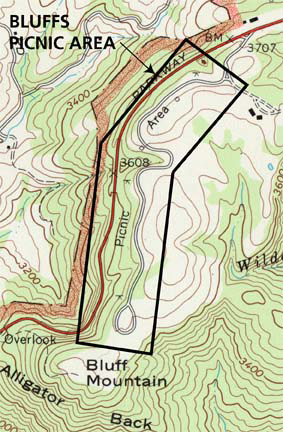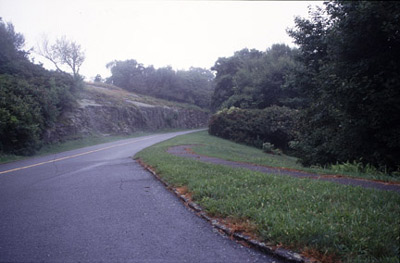Bluffs Picnic Area was one of the first picnic areas designed and built along the Blue Ridge Parkway. The component landscape, part of the Doughton Park landscape, contributes to the significance of the parkway as a National Historic Landmark. The first portion of Ridge Road was completed by 1939, along with picnic sites, trails, and fireplaces in the rustic style. Later development, such as the second comfort station (c. 1959), uses the utilitarian style that was more typical to that period.

USGS Quadrangle, 1968
Bluffs Picnic Area is an 80-acre component landscape within Doughton Park, a Blue Ridge Parkway developed area in North Carolina. The site is located at parkway Milepost 241.1. It is accessed by Ridge Road parallels the eastern side of the parkway and spans the entire picnic area before it terminates in a cul de sac.
Bluffs Picnic Area was one of the first picnic facilities planned for Blue Ridge Parkway. The first section was completed in the late 1930s. An extension was proposed during this time, and then designed and built in the 1950s. The picnic area takes advantage of the rolling terrain of the Bluffs area, offering views of the surrounding mountain laurel meadows and featuring rustic picnic sites that are secluded in the scattered forest. The first comfort station was built in 1941. It is notable both for its rustic, Adirondack style architecture and its prominent position above the first Ridge Road parking area.

NPS
The second comfort station was built nearly two decades later, and it better represents the later, utilitarian style found at Blue Ridge. Many of the pathways leading through the picnic area were designed and built in the late 1930s and early 1940s. Their location and the use of stone steps and log interrupters are consistent with the design specifications of the parkway. There are also early examples of picnic tables, fireplaces, and drinking fountains.
The setting of mountain laurel and rhododendron meadows interspersed with patches of forest figured prominently in this location for the picnic area. A 1942 planting plan called for the enhancement of this existing flora. This included a few trees suggested for the entry, more rhododendron and mountain laurel throughout, and smaller, lower-growing species for the rock ledges, enhancing the rock garden feeling of the rock ledges along Ridge Road.

NPS
As one of the first picnic areas designed and built in the park, the property contributes to the historical significance of the parkway. The development that took place during the first three periods of Blue Ridge history (1936 – 1955) contributes to the national significance of Blue Ridge as an National Historic Landmark. These features include the entire length of Ridge Road, since the second portion was designed before 1955 and construction completed shortly after. It also includes the comfort station and trail shelter, the c. 1939 trails, picnic sites and drinking fountains, as well as the vegetation, including what remains of the 1940 planting design.
Picnic sites along the southern end of the extension show the progression from the rustic style common during the first three periods of Blue Ridge development (1933 – 1955), to the last two periods (1956 – 1987). The planting plans for the property, completed in the 1940s, further enhance the naturalistic style already in place, with low growing plants used in the rock ledges, more mountain laurel and rhododendron in open areas, and a few trees at the entry. Evidence of this naturalistic planting style is still seen today.
Quick Facts
- Cultural Landscape Type: Designed
- National Register Significance Level: National
- National Register Significance Criteria: A, C
- Period of Significance: 1933-1987
Landscape Links
Part of a series of articles titled Cultural Landscapes of Blue Ridge Parkway: Doughton Park.
Last updated: December 31, 2020
